Business Process Reengineering: Analysis of Duke Power, Deere, and IBM
VerifiedAdded on 2021/07/28
|13
|3478
|179
Report
AI Summary
This report provides a comprehensive analysis of Business Process Reengineering (BPR), starting with its definition and key concepts as presented in the works of Hammer and Champy, and linking it to the principles of Human Resource Management (HRM). The report explores the motivations for reengineering, including customer focus, competition, and constant change. It then delves into the characteristics of reengineered organizations, the process of rethinking business processes, and the identification of reengineering opportunities. The core of the report involves detailed case studies of Duke Power, Deere & Company, and IBM, examining their reengineering initiatives, the challenges they faced, and the lessons learned. The report also discusses the role of job analysis within the context of BPR and highlights key considerations. The report concludes with an analysis of the HRM functions within the context of BPR and its influence on business development and organizational structure.

0
Paraphrase This Document
Need a fresh take? Get an instant paraphrase of this document with our AI Paraphraser
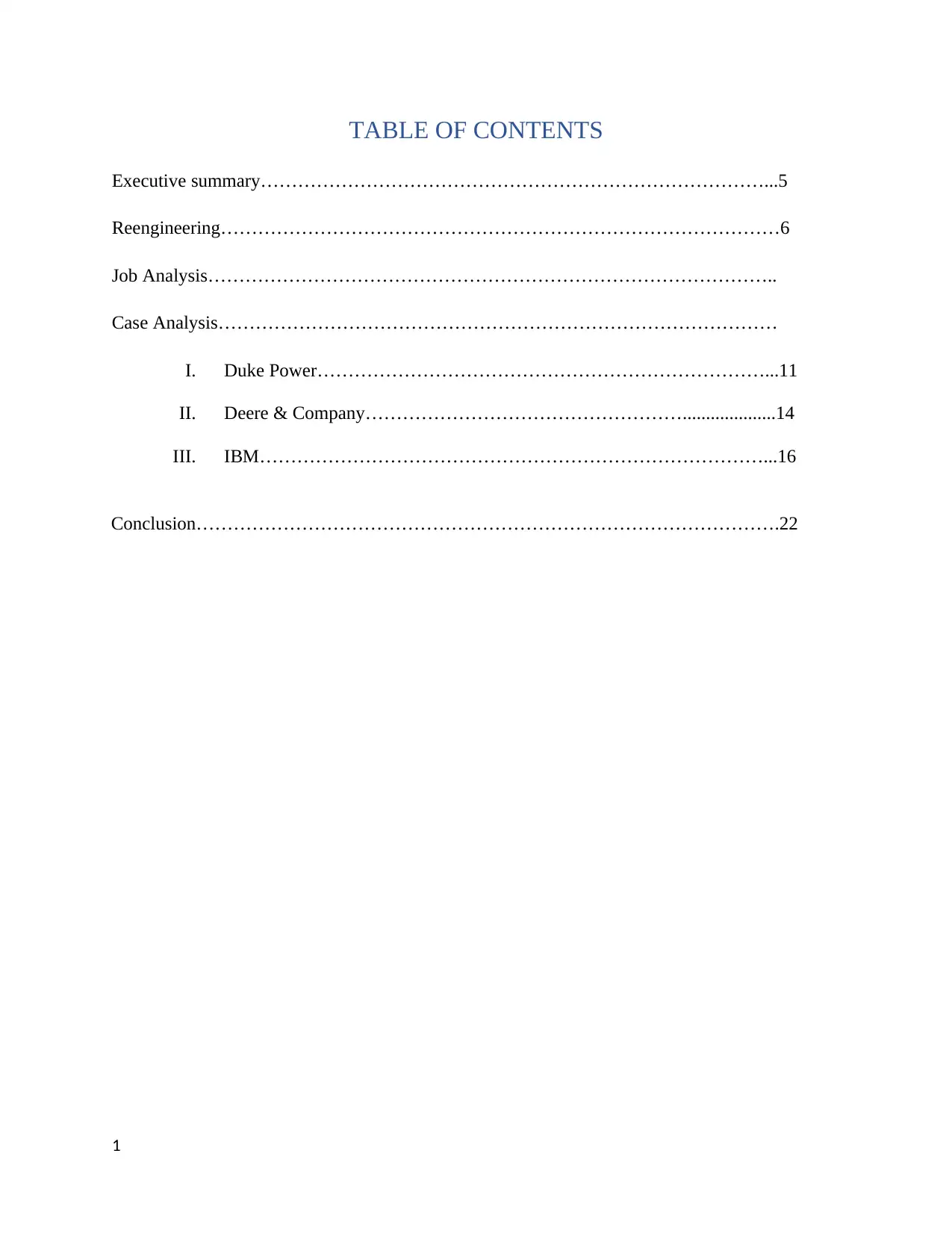
TABLE OF CONTENTS
Executive summary………………………………………………………………………...5
Reengineering………………………………………………………………………………6
Job Analysis………………………………………………………………………………..
Case Analysis………………………………………………………………………………
I. Duke Power………………………………………………………………...11
II. Deere & Company……………………………………………....................14
III. IBM………………………………………………………………………...16
Conclusion………………………………………………………………………………….22
1
Executive summary………………………………………………………………………...5
Reengineering………………………………………………………………………………6
Job Analysis………………………………………………………………………………..
Case Analysis………………………………………………………………………………
I. Duke Power………………………………………………………………...11
II. Deere & Company……………………………………………....................14
III. IBM………………………………………………………………………...16
Conclusion………………………………………………………………………………….22
1
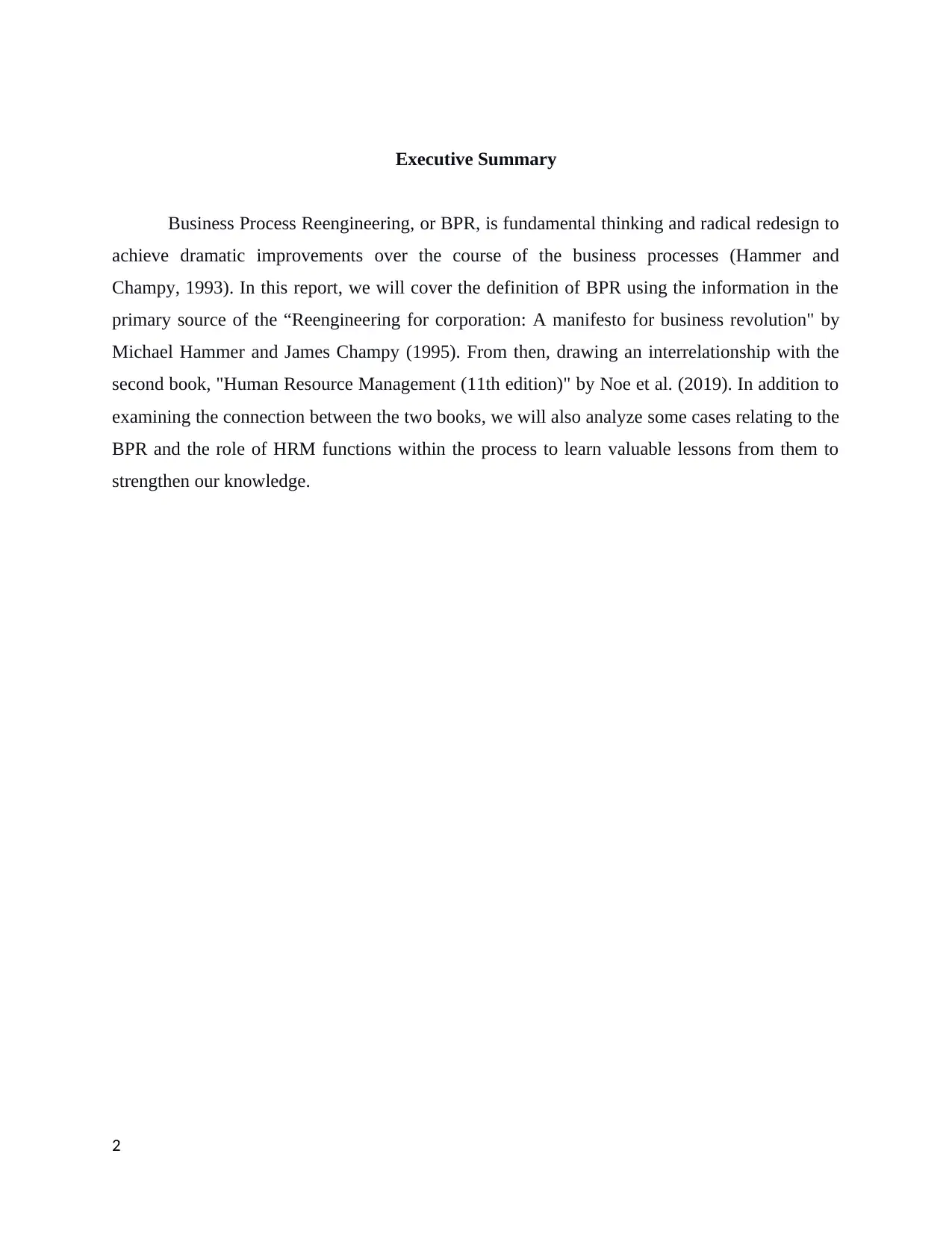
Executive Summary
Business Process Reengineering, or BPR, is fundamental thinking and radical redesign to
achieve dramatic improvements over the course of the business processes (Hammer and
Champy, 1993). In this report, we will cover the definition of BPR using the information in the
primary source of the “Reengineering for corporation: A manifesto for business revolution" by
Michael Hammer and James Champy (1995). From then, drawing an interrelationship with the
second book, "Human Resource Management (11th edition)" by Noe et al. (2019). In addition to
examining the connection between the two books, we will also analyze some cases relating to the
BPR and the role of HRM functions within the process to learn valuable lessons from them to
strengthen our knowledge.
2
Business Process Reengineering, or BPR, is fundamental thinking and radical redesign to
achieve dramatic improvements over the course of the business processes (Hammer and
Champy, 1993). In this report, we will cover the definition of BPR using the information in the
primary source of the “Reengineering for corporation: A manifesto for business revolution" by
Michael Hammer and James Champy (1995). From then, drawing an interrelationship with the
second book, "Human Resource Management (11th edition)" by Noe et al. (2019). In addition to
examining the connection between the two books, we will also analyze some cases relating to the
BPR and the role of HRM functions within the process to learn valuable lessons from them to
strengthen our knowledge.
2
⊘ This is a preview!⊘
Do you want full access?
Subscribe today to unlock all pages.

Trusted by 1+ million students worldwide

REENGINEERING
Reengineering generally involves going back to the beginning and inventing a better way
of doing work. At some point, an organization had to start all over again from the bottom in
order to achieve desired success. It is about gradually rejecting the conventional wisdom and
received assumptions of the past and inventing new approaches to process structure that bear
little or no resemblance to those of previous eras.
This definition contains four keywords: Fundamental, Radical, Dramatic, and Process.
There are three kinds of companies that need reengineering: companies in deep trouble,
companies that are not yet in trouble but had the foresight to see trouble coming, companies in
peak condition but desired great development.
With Alan Smith’s principles had become obsolete in today’s world’s fast-changing and
unpredictable economy; managers cannot assess their company’s growth, determine the market
growth, customer demand, or the product life cycles using the same old approach. The basic
motivations for reengineering, which now play a significant role in directing organizations on
their path, include the 3Cs: Customers take charge, Competition intensifies, and Change
becomes constant.
1. Customers take charge
In the present time, customers’ tastes and special needs are often taken into account and
satisfied. However, sellers used to have the upper hand in the past; there were very few
competitors among the sellers, so the market did not have much to offer. Same products and
services would be sold repeatedly, and the consumers would have to buy whatever was available
on the market. As for now, when countries are leveraging off the free trade deal, the markets now
have more selections, and the demand for personalized products and services rises. The textbook
has clearly stated that “There is no longer any such notion as the customer; there is only this
customer.
3
Reengineering generally involves going back to the beginning and inventing a better way
of doing work. At some point, an organization had to start all over again from the bottom in
order to achieve desired success. It is about gradually rejecting the conventional wisdom and
received assumptions of the past and inventing new approaches to process structure that bear
little or no resemblance to those of previous eras.
This definition contains four keywords: Fundamental, Radical, Dramatic, and Process.
There are three kinds of companies that need reengineering: companies in deep trouble,
companies that are not yet in trouble but had the foresight to see trouble coming, companies in
peak condition but desired great development.
With Alan Smith’s principles had become obsolete in today’s world’s fast-changing and
unpredictable economy; managers cannot assess their company’s growth, determine the market
growth, customer demand, or the product life cycles using the same old approach. The basic
motivations for reengineering, which now play a significant role in directing organizations on
their path, include the 3Cs: Customers take charge, Competition intensifies, and Change
becomes constant.
1. Customers take charge
In the present time, customers’ tastes and special needs are often taken into account and
satisfied. However, sellers used to have the upper hand in the past; there were very few
competitors among the sellers, so the market did not have much to offer. Same products and
services would be sold repeatedly, and the consumers would have to buy whatever was available
on the market. As for now, when countries are leveraging off the free trade deal, the markets now
have more selections, and the demand for personalized products and services rises. The textbook
has clearly stated that “There is no longer any such notion as the customer; there is only this
customer.
3
Paraphrase This Document
Need a fresh take? Get an instant paraphrase of this document with our AI Paraphraser

2. Competition intensifies
As the trade barriers are gradually falling apart, many countries are free to compete in the
same market. Good performers will outrun the other competitors because goods and services
with the lowest price and the best quality will soon become the new standard for all.
In addition, technology is also a factor that changes the nature of competition, such as the
retailing industry, after-sales service. Companies can expand the limits of the possible and raise
the customers’ expectations for all the companies in the market by innovating with the
technology to streamline the interaction between themselves and their customers.
Moreover, start-ups can be a new issue for big businesses because they are new and don’t
play by the rules. They create new rules about how to run a business. Since start-ups carry no
organizational history, they can enter the market with the next product or service generation.
3. Change becomes constant
Lastly, the pace of the change has accelerated, companies will likely face a great number
of competitors. Not only have products and service life cycles diminished, but the time available
to develop new products and introduce them would also decrease. The changes that happen
outside of the organizations’ expectations will possibly put them out of business. Today,
companies must move fast, or they won’t be moving at all.
Rethinking Business Processes
When a company Rethinks its Business Processes, it must “Think outside the box”,
which means learning to think inductively to explore and recognize hidden capabilities of
technology instead of using familiar ones to do tasks. Companies don’t reengineer their
processes, the people in the organization do it. Those are leader, process owner, reengineering
team, steering committee, and reengineering czar.
There are nine characteristics of reengineered organizations:
1. Several tasks are merged into one.
2. Workers make decisions.
3. The process steps are carried out in a logical sequence.
4
As the trade barriers are gradually falling apart, many countries are free to compete in the
same market. Good performers will outrun the other competitors because goods and services
with the lowest price and the best quality will soon become the new standard for all.
In addition, technology is also a factor that changes the nature of competition, such as the
retailing industry, after-sales service. Companies can expand the limits of the possible and raise
the customers’ expectations for all the companies in the market by innovating with the
technology to streamline the interaction between themselves and their customers.
Moreover, start-ups can be a new issue for big businesses because they are new and don’t
play by the rules. They create new rules about how to run a business. Since start-ups carry no
organizational history, they can enter the market with the next product or service generation.
3. Change becomes constant
Lastly, the pace of the change has accelerated, companies will likely face a great number
of competitors. Not only have products and service life cycles diminished, but the time available
to develop new products and introduce them would also decrease. The changes that happen
outside of the organizations’ expectations will possibly put them out of business. Today,
companies must move fast, or they won’t be moving at all.
Rethinking Business Processes
When a company Rethinks its Business Processes, it must “Think outside the box”,
which means learning to think inductively to explore and recognize hidden capabilities of
technology instead of using familiar ones to do tasks. Companies don’t reengineer their
processes, the people in the organization do it. Those are leader, process owner, reengineering
team, steering committee, and reengineering czar.
There are nine characteristics of reengineered organizations:
1. Several tasks are merged into one.
2. Workers make decisions.
3. The process steps are carried out in a logical sequence.
4

4. Processes have multiple versions.
5. Work is done in the most logical place.
6. Controls and checks are being lowered.
7. Reconciliation is minimized.
8. A case manager acts as a single point of contact for clients.
9. The use of hybrid centralized-decentralized is common.
Changes that occur when a corporation reengineers its business processes:
1. Work units evolve, shifting from functional departments to process teams.
2. Jobs move from simple duties to multidimensional tasks.
3. People’s roles shift from being controlled to being empowered.
4. Job preparation evolves, shifting from training to education.
5. The concentration of performance metrics and remuneration moves from activity
to results.
6. Criteria for advancement change from performance to ability.
7. Values shift from protective to productive: work for the client, not their employer.
8. Managers switch from supervisors to coaches.
9. Organizational structures evolve, shifting from hierarchical to flat.
10. Executives transition from being scorekeepers to leaders.
The Hunt for Reengineering Opportunities
Companies and organizations nowadays have to revolve around the word ‘process’,
because process plays a significant role in the progress of reengineering a company. Therefore,
one of the most important steps is choosing the right processes to reengineer. Once processes are
identified and mapped, deciding which ones require reengineering and the order in which they
should be tackled is not a trivial task as no company can reengineer all of its processes
simultaneously.
There are three criteria on which companies can rely to determine which processes need
to be reengineered:
5
5. Work is done in the most logical place.
6. Controls and checks are being lowered.
7. Reconciliation is minimized.
8. A case manager acts as a single point of contact for clients.
9. The use of hybrid centralized-decentralized is common.
Changes that occur when a corporation reengineers its business processes:
1. Work units evolve, shifting from functional departments to process teams.
2. Jobs move from simple duties to multidimensional tasks.
3. People’s roles shift from being controlled to being empowered.
4. Job preparation evolves, shifting from training to education.
5. The concentration of performance metrics and remuneration moves from activity
to results.
6. Criteria for advancement change from performance to ability.
7. Values shift from protective to productive: work for the client, not their employer.
8. Managers switch from supervisors to coaches.
9. Organizational structures evolve, shifting from hierarchical to flat.
10. Executives transition from being scorekeepers to leaders.
The Hunt for Reengineering Opportunities
Companies and organizations nowadays have to revolve around the word ‘process’,
because process plays a significant role in the progress of reengineering a company. Therefore,
one of the most important steps is choosing the right processes to reengineer. Once processes are
identified and mapped, deciding which ones require reengineering and the order in which they
should be tackled is not a trivial task as no company can reengineer all of its processes
simultaneously.
There are three criteria on which companies can rely to determine which processes need
to be reengineered:
5
⊘ This is a preview!⊘
Do you want full access?
Subscribe today to unlock all pages.

Trusted by 1+ million students worldwide
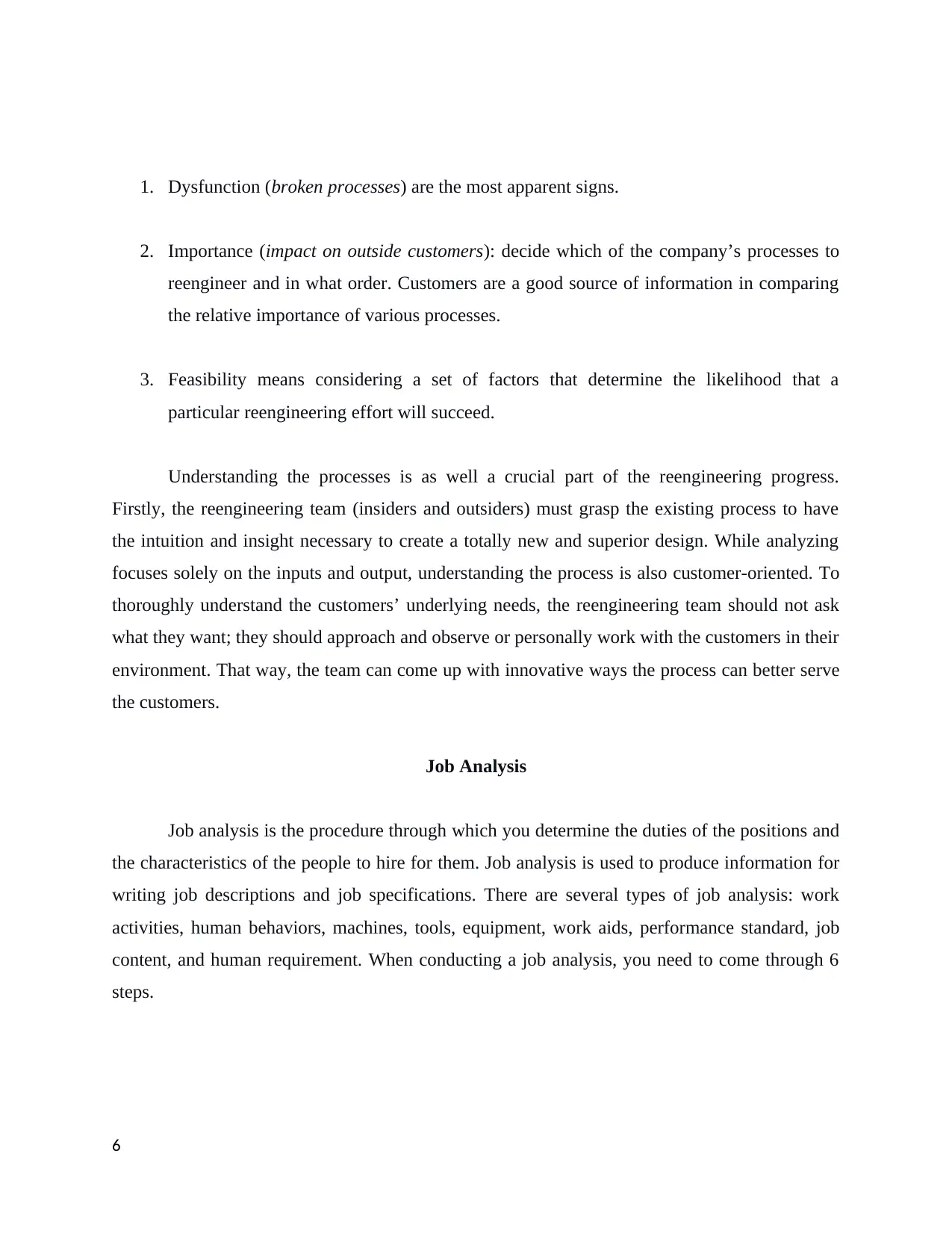
1. Dysfunction (broken processes) are the most apparent signs.
2. Importance (impact on outside customers): decide which of the company’s processes to
reengineer and in what order. Customers are a good source of information in comparing
the relative importance of various processes.
3. Feasibility means considering a set of factors that determine the likelihood that a
particular reengineering effort will succeed.
Understanding the processes is as well a crucial part of the reengineering progress.
Firstly, the reengineering team (insiders and outsiders) must grasp the existing process to have
the intuition and insight necessary to create a totally new and superior design. While analyzing
focuses solely on the inputs and output, understanding the process is also customer-oriented. To
thoroughly understand the customers’ underlying needs, the reengineering team should not ask
what they want; they should approach and observe or personally work with the customers in their
environment. That way, the team can come up with innovative ways the process can better serve
the customers.
Job Analysis
Job analysis is the procedure through which you determine the duties of the positions and
the characteristics of the people to hire for them. Job analysis is used to produce information for
writing job descriptions and job specifications. There are several types of job analysis: work
activities, human behaviors, machines, tools, equipment, work aids, performance standard, job
content, and human requirement. When conducting a job analysis, you need to come through 6
steps.
6
2. Importance (impact on outside customers): decide which of the company’s processes to
reengineer and in what order. Customers are a good source of information in comparing
the relative importance of various processes.
3. Feasibility means considering a set of factors that determine the likelihood that a
particular reengineering effort will succeed.
Understanding the processes is as well a crucial part of the reengineering progress.
Firstly, the reengineering team (insiders and outsiders) must grasp the existing process to have
the intuition and insight necessary to create a totally new and superior design. While analyzing
focuses solely on the inputs and output, understanding the process is also customer-oriented. To
thoroughly understand the customers’ underlying needs, the reengineering team should not ask
what they want; they should approach and observe or personally work with the customers in their
environment. That way, the team can come up with innovative ways the process can better serve
the customers.
Job Analysis
Job analysis is the procedure through which you determine the duties of the positions and
the characteristics of the people to hire for them. Job analysis is used to produce information for
writing job descriptions and job specifications. There are several types of job analysis: work
activities, human behaviors, machines, tools, equipment, work aids, performance standard, job
content, and human requirement. When conducting a job analysis, you need to come through 6
steps.
6
Paraphrase This Document
Need a fresh take? Get an instant paraphrase of this document with our AI Paraphraser
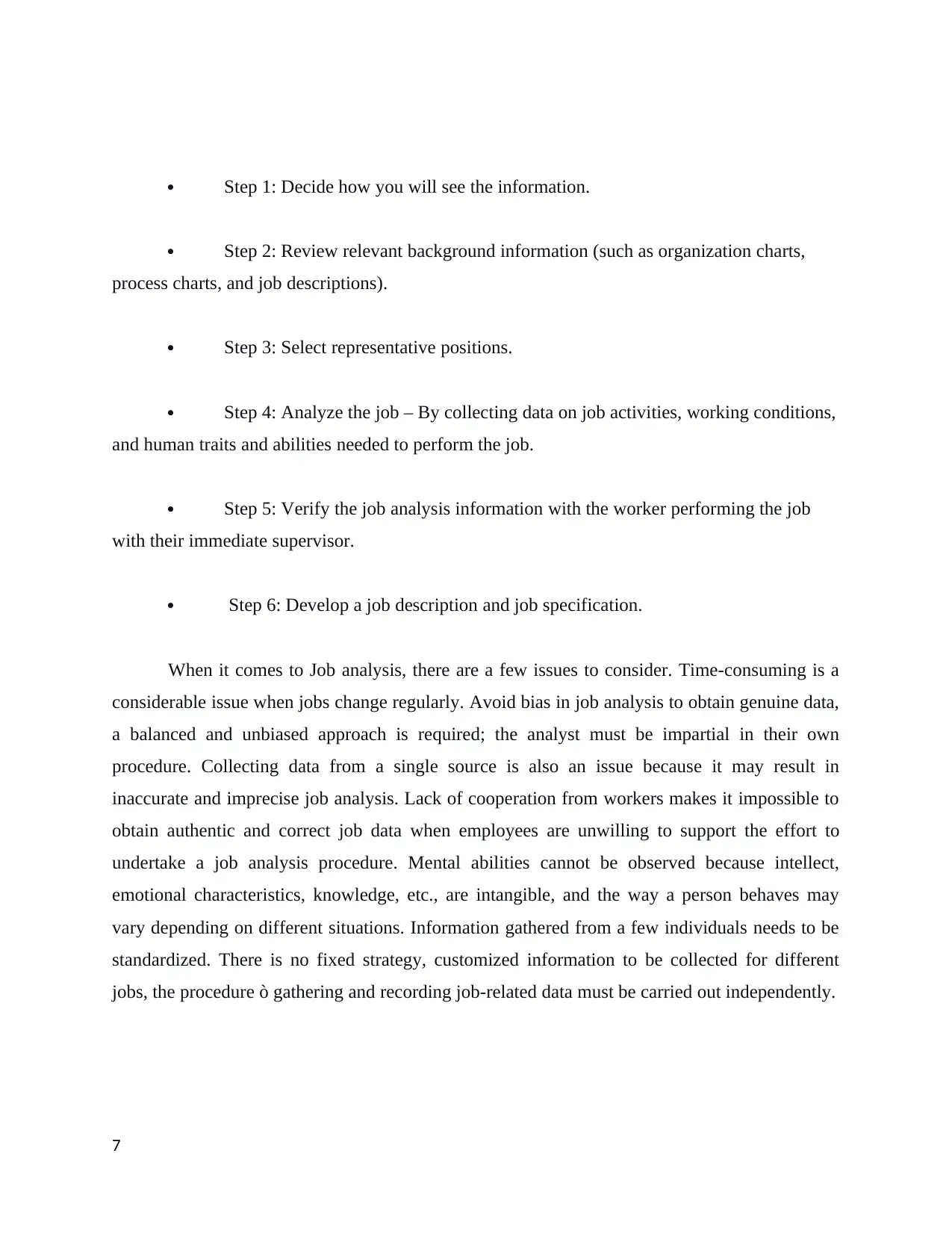
Step 1: Decide how you will see the information.
Step 2: Review relevant background information (such as organization charts,
process charts, and job descriptions).
Step 3: Select representative positions.
Step 4: Analyze the job – By collecting data on job activities, working conditions,
and human traits and abilities needed to perform the job.
Step 5: Verify the job analysis information with the worker performing the job
with their immediate supervisor.
Step 6: Develop a job description and job specification.
When it comes to Job analysis, there are a few issues to consider. Time-consuming is a
considerable issue when jobs change regularly. Avoid bias in job analysis to obtain genuine data,
a balanced and unbiased approach is required; the analyst must be impartial in their own
procedure. Collecting data from a single source is also an issue because it may result in
inaccurate and imprecise job analysis. Lack of cooperation from workers makes it impossible to
obtain authentic and correct job data when employees are unwilling to support the effort to
undertake a job analysis procedure. Mental abilities cannot be observed because intellect,
emotional characteristics, knowledge, etc., are intangible, and the way a person behaves may
vary depending on different situations. Information gathered from a few individuals needs to be
standardized. There is no fixed strategy, customized information to be collected for different
jobs, the procedure ò gathering and recording job-related data must be carried out independently.
7
Step 2: Review relevant background information (such as organization charts,
process charts, and job descriptions).
Step 3: Select representative positions.
Step 4: Analyze the job – By collecting data on job activities, working conditions,
and human traits and abilities needed to perform the job.
Step 5: Verify the job analysis information with the worker performing the job
with their immediate supervisor.
Step 6: Develop a job description and job specification.
When it comes to Job analysis, there are a few issues to consider. Time-consuming is a
considerable issue when jobs change regularly. Avoid bias in job analysis to obtain genuine data,
a balanced and unbiased approach is required; the analyst must be impartial in their own
procedure. Collecting data from a single source is also an issue because it may result in
inaccurate and imprecise job analysis. Lack of cooperation from workers makes it impossible to
obtain authentic and correct job data when employees are unwilling to support the effort to
undertake a job analysis procedure. Mental abilities cannot be observed because intellect,
emotional characteristics, knowledge, etc., are intangible, and the way a person behaves may
vary depending on different situations. Information gathered from a few individuals needs to be
standardized. There is no fixed strategy, customized information to be collected for different
jobs, the procedure ò gathering and recording job-related data must be carried out independently.
7

CASE ANALYSIS
Case Study of Duke Power
Duke Power is one of the largest energy companies in the United States. It was founded
by Dr. W. Gill Wylie, James Buchanan Duke, and William States Lee. The reason for
reengineering was to remain competitive when deregulation arrived in 1999. Therefore, the
chairman, the president, and the CEO of Duke Energy recognized that the utility needed to cut
costs and further improve its customer service, and they started to reengineer.
In the past, the old system that used to make Duke Power so prosperous and powerful
included the customer operations taking in all the employees within the towns and cities that the
company serves who are needed to transfer the energy from the high-voltage system to the
customer. However, as Duke Power came closer to the reengineering path, they had to cut the
delivery cost while simultaneously improving the quality of service if they wanted to be ready
for the competition. They had to deal with all the negative “that won’t work here” comments and
wasted energy debating whether or not to do something. Ferrell had disclosed that under the old
system, no one made any attempt to determine whether a particular job would take one hour or
two hours or whatever. When they started reengineering, they had thirteen geographical areas
and did everything thirteen different ways, change would not work in such-and-such an area,
nothing much was ever improved. Difficulties arose as the reengineering process continued;
while designing and refining their work processes, they damaged the trust and intimacy they had
built up over the years. Their field supervisors were gone, and this led to miscommunication.
Nevertheless, Duke Power had ground-breaking steps on their path of reengineering.
They created a system for determining how long a job should take, ranging from heavy
construction to routine work. As a result, they sent people out for the day with less than a day’s
work. In addition, they began color-coding to designate levels of priority and put together
packages of a full day’s work that are distributed to employees; this had increased productivity
without making folks work a lot harder. In some areas, they were holding the line on O&M cost
per customer added, which means they were absorbing 2.5 percent customer growth along with
inflation, and all the customer surveys are high and getting higher. Duke Power also came up
with some new options, like faxing in applications, which was easier for contractors/builders;
8
Case Study of Duke Power
Duke Power is one of the largest energy companies in the United States. It was founded
by Dr. W. Gill Wylie, James Buchanan Duke, and William States Lee. The reason for
reengineering was to remain competitive when deregulation arrived in 1999. Therefore, the
chairman, the president, and the CEO of Duke Energy recognized that the utility needed to cut
costs and further improve its customer service, and they started to reengineer.
In the past, the old system that used to make Duke Power so prosperous and powerful
included the customer operations taking in all the employees within the towns and cities that the
company serves who are needed to transfer the energy from the high-voltage system to the
customer. However, as Duke Power came closer to the reengineering path, they had to cut the
delivery cost while simultaneously improving the quality of service if they wanted to be ready
for the competition. They had to deal with all the negative “that won’t work here” comments and
wasted energy debating whether or not to do something. Ferrell had disclosed that under the old
system, no one made any attempt to determine whether a particular job would take one hour or
two hours or whatever. When they started reengineering, they had thirteen geographical areas
and did everything thirteen different ways, change would not work in such-and-such an area,
nothing much was ever improved. Difficulties arose as the reengineering process continued;
while designing and refining their work processes, they damaged the trust and intimacy they had
built up over the years. Their field supervisors were gone, and this led to miscommunication.
Nevertheless, Duke Power had ground-breaking steps on their path of reengineering.
They created a system for determining how long a job should take, ranging from heavy
construction to routine work. As a result, they sent people out for the day with less than a day’s
work. In addition, they began color-coding to designate levels of priority and put together
packages of a full day’s work that are distributed to employees; this had increased productivity
without making folks work a lot harder. In some areas, they were holding the line on O&M cost
per customer added, which means they were absorbing 2.5 percent customer growth along with
inflation, and all the customer surveys are high and getting higher. Duke Power also came up
with some new options, like faxing in applications, which was easier for contractors/builders;
8
⊘ This is a preview!⊘
Do you want full access?
Subscribe today to unlock all pages.

Trusted by 1+ million students worldwide
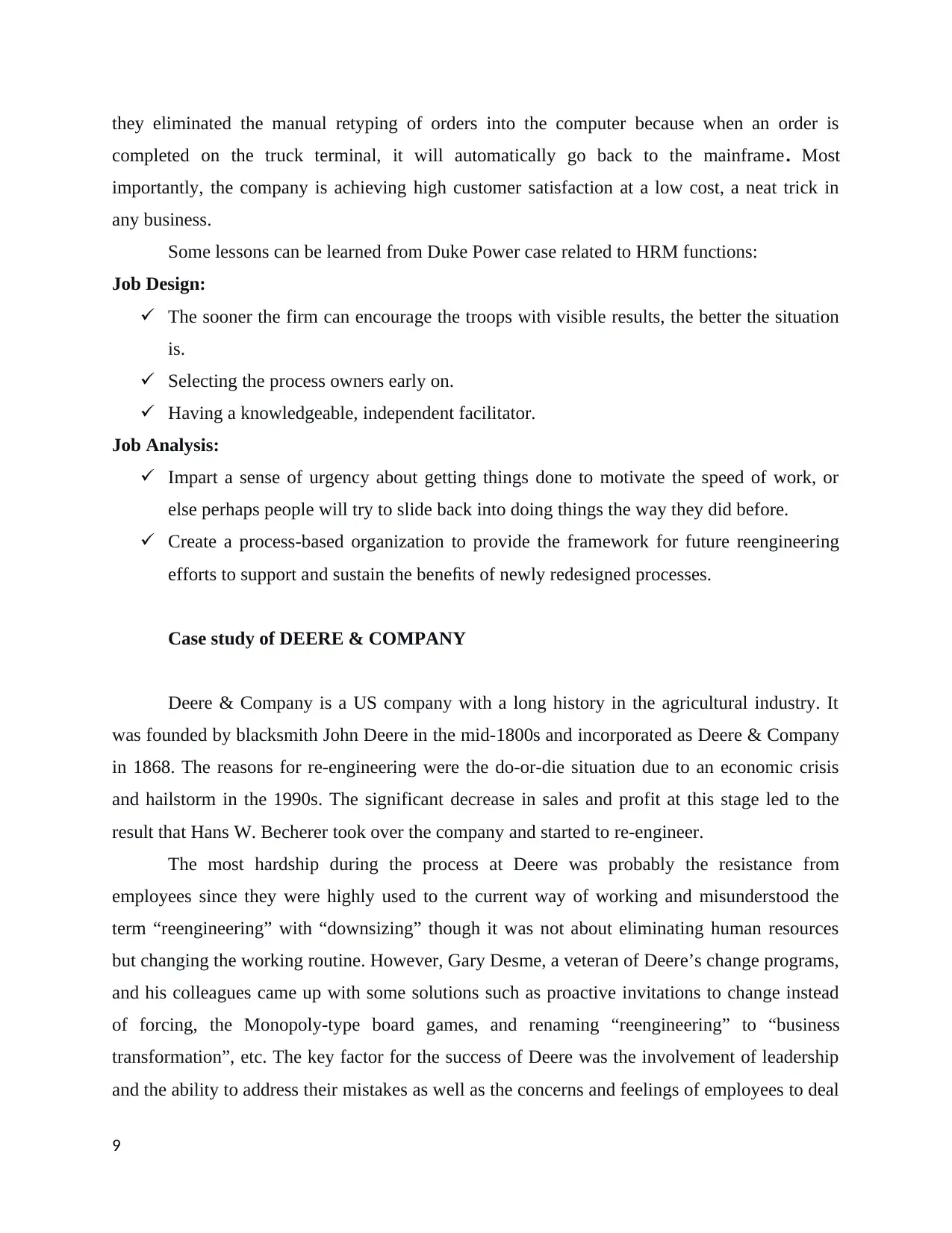
they eliminated the manual retyping of orders into the computer because when an order is
completed on the truck terminal, it will automatically go back to the mainframe. Most
importantly, the company is achieving high customer satisfaction at a low cost, a neat trick in
any business.
Some lessons can be learned from Duke Power case related to HRM functions:
Job Design:
The sooner the firm can encourage the troops with visible results, the better the situation
is.
Selecting the process owners early on.
Having a knowledgeable, independent facilitator.
Job Analysis:
Impart a sense of urgency about getting things done to motivate the speed of work, or
else perhaps people will try to slide back into doing things the way they did before.
Create a process-based organization to provide the framework for future reengineering
efforts to support and sustain the benefits of newly redesigned processes.
Case study of DEERE & COMPANY
Deere & Company is a US company with a long history in the agricultural industry. It
was founded by blacksmith John Deere in the mid-1800s and incorporated as Deere & Company
in 1868. The reasons for re-engineering were the do-or-die situation due to an economic crisis
and hailstorm in the 1990s. The significant decrease in sales and profit at this stage led to the
result that Hans W. Becherer took over the company and started to re-engineer.
The most hardship during the process at Deere was probably the resistance from
employees since they were highly used to the current way of working and misunderstood the
term “reengineering” with “downsizing” though it was not about eliminating human resources
but changing the working routine. However, Gary Desme, a veteran of Deere’s change programs,
and his colleagues came up with some solutions such as proactive invitations to change instead
of forcing, the Monopoly-type board games, and renaming “reengineering” to “business
transformation”, etc. The key factor for the success of Deere was the involvement of leadership
and the ability to address their mistakes as well as the concerns and feelings of employees to deal
9
completed on the truck terminal, it will automatically go back to the mainframe. Most
importantly, the company is achieving high customer satisfaction at a low cost, a neat trick in
any business.
Some lessons can be learned from Duke Power case related to HRM functions:
Job Design:
The sooner the firm can encourage the troops with visible results, the better the situation
is.
Selecting the process owners early on.
Having a knowledgeable, independent facilitator.
Job Analysis:
Impart a sense of urgency about getting things done to motivate the speed of work, or
else perhaps people will try to slide back into doing things the way they did before.
Create a process-based organization to provide the framework for future reengineering
efforts to support and sustain the benefits of newly redesigned processes.
Case study of DEERE & COMPANY
Deere & Company is a US company with a long history in the agricultural industry. It
was founded by blacksmith John Deere in the mid-1800s and incorporated as Deere & Company
in 1868. The reasons for re-engineering were the do-or-die situation due to an economic crisis
and hailstorm in the 1990s. The significant decrease in sales and profit at this stage led to the
result that Hans W. Becherer took over the company and started to re-engineer.
The most hardship during the process at Deere was probably the resistance from
employees since they were highly used to the current way of working and misunderstood the
term “reengineering” with “downsizing” though it was not about eliminating human resources
but changing the working routine. However, Gary Desme, a veteran of Deere’s change programs,
and his colleagues came up with some solutions such as proactive invitations to change instead
of forcing, the Monopoly-type board games, and renaming “reengineering” to “business
transformation”, etc. The key factor for the success of Deere was the involvement of leadership
and the ability to address their mistakes as well as the concerns and feelings of employees to deal
9
Paraphrase This Document
Need a fresh take? Get an instant paraphrase of this document with our AI Paraphraser
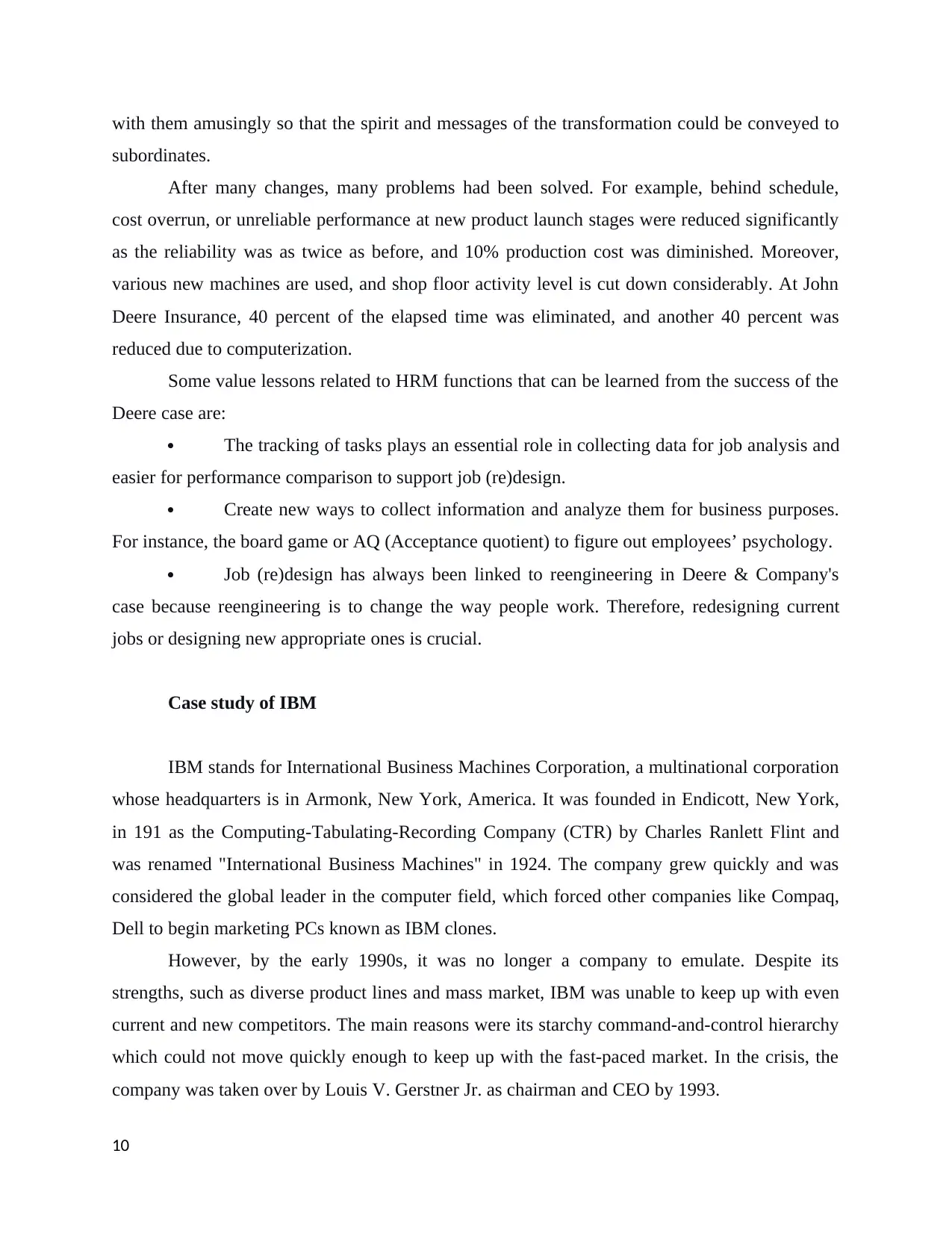
with them amusingly so that the spirit and messages of the transformation could be conveyed to
subordinates.
After many changes, many problems had been solved. For example, behind schedule,
cost overrun, or unreliable performance at new product launch stages were reduced significantly
as the reliability was as twice as before, and 10% production cost was diminished. Moreover,
various new machines are used, and shop floor activity level is cut down considerably. At John
Deere Insurance, 40 percent of the elapsed time was eliminated, and another 40 percent was
reduced due to computerization.
Some value lessons related to HRM functions that can be learned from the success of the
Deere case are:
The tracking of tasks plays an essential role in collecting data for job analysis and
easier for performance comparison to support job (re)design.
Create new ways to collect information and analyze them for business purposes.
For instance, the board game or AQ (Acceptance quotient) to figure out employees’ psychology.
Job (re)design has always been linked to reengineering in Deere & Company's
case because reengineering is to change the way people work. Therefore, redesigning current
jobs or designing new appropriate ones is crucial.
Case study of IBM
IBM stands for International Business Machines Corporation, a multinational corporation
whose headquarters is in Armonk, New York, America. It was founded in Endicott, New York,
in 191 as the Computing-Tabulating-Recording Company (CTR) by Charles Ranlett Flint and
was renamed "International Business Machines" in 1924. The company grew quickly and was
considered the global leader in the computer field, which forced other companies like Compaq,
Dell to begin marketing PCs known as IBM clones.
However, by the early 1990s, it was no longer a company to emulate. Despite its
strengths, such as diverse product lines and mass market, IBM was unable to keep up with even
current and new competitors. The main reasons were its starchy command-and-control hierarchy
which could not move quickly enough to keep up with the fast-paced market. In the crisis, the
company was taken over by Louis V. Gerstner Jr. as chairman and CEO by 1993.
10
subordinates.
After many changes, many problems had been solved. For example, behind schedule,
cost overrun, or unreliable performance at new product launch stages were reduced significantly
as the reliability was as twice as before, and 10% production cost was diminished. Moreover,
various new machines are used, and shop floor activity level is cut down considerably. At John
Deere Insurance, 40 percent of the elapsed time was eliminated, and another 40 percent was
reduced due to computerization.
Some value lessons related to HRM functions that can be learned from the success of the
Deere case are:
The tracking of tasks plays an essential role in collecting data for job analysis and
easier for performance comparison to support job (re)design.
Create new ways to collect information and analyze them for business purposes.
For instance, the board game or AQ (Acceptance quotient) to figure out employees’ psychology.
Job (re)design has always been linked to reengineering in Deere & Company's
case because reengineering is to change the way people work. Therefore, redesigning current
jobs or designing new appropriate ones is crucial.
Case study of IBM
IBM stands for International Business Machines Corporation, a multinational corporation
whose headquarters is in Armonk, New York, America. It was founded in Endicott, New York,
in 191 as the Computing-Tabulating-Recording Company (CTR) by Charles Ranlett Flint and
was renamed "International Business Machines" in 1924. The company grew quickly and was
considered the global leader in the computer field, which forced other companies like Compaq,
Dell to begin marketing PCs known as IBM clones.
However, by the early 1990s, it was no longer a company to emulate. Despite its
strengths, such as diverse product lines and mass market, IBM was unable to keep up with even
current and new competitors. The main reasons were its starchy command-and-control hierarchy
which could not move quickly enough to keep up with the fast-paced market. In the crisis, the
company was taken over by Louis V. Gerstner Jr. as chairman and CEO by 1993.
10
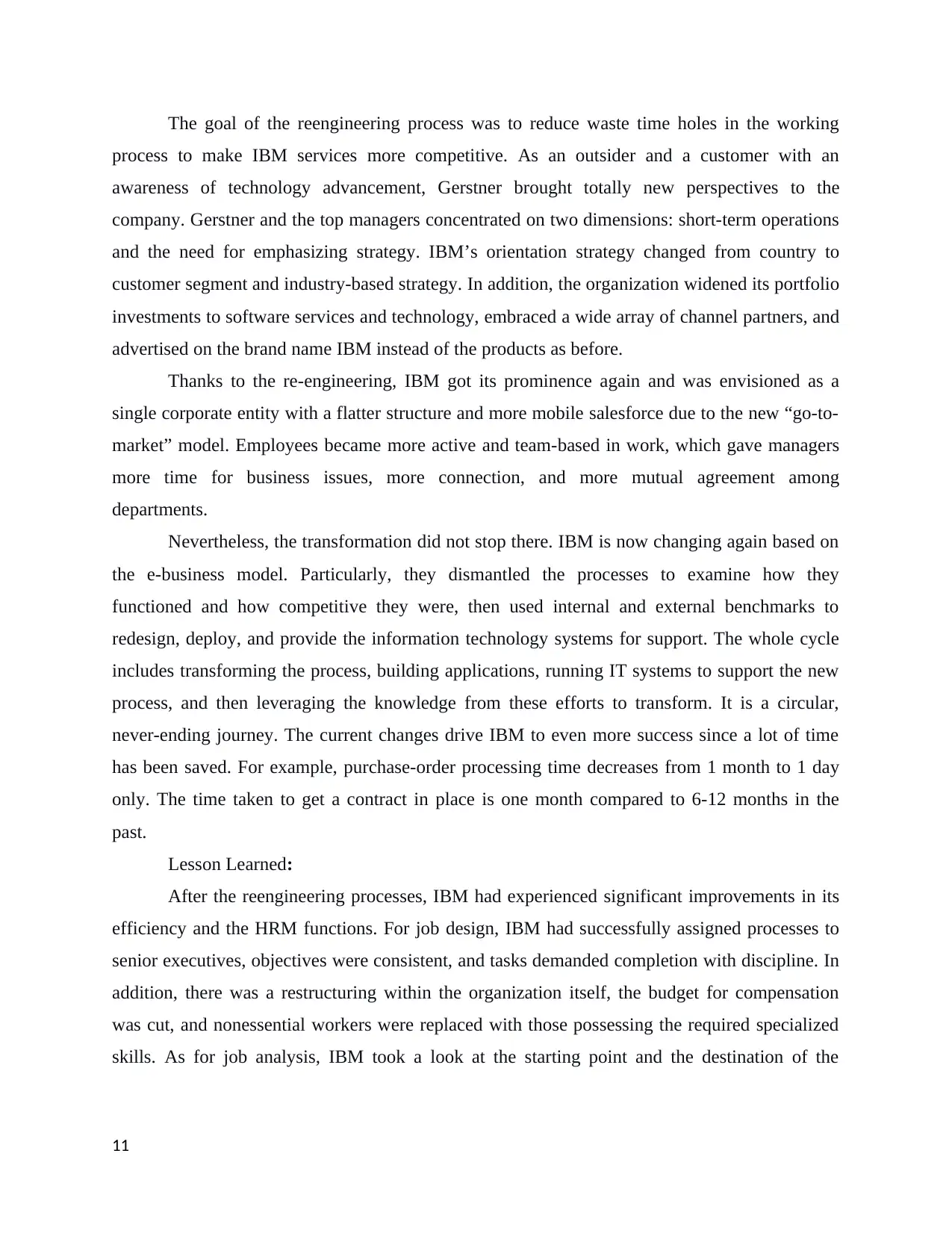
The goal of the reengineering process was to reduce waste time holes in the working
process to make IBM services more competitive. As an outsider and a customer with an
awareness of technology advancement, Gerstner brought totally new perspectives to the
company. Gerstner and the top managers concentrated on two dimensions: short-term operations
and the need for emphasizing strategy. IBM’s orientation strategy changed from country to
customer segment and industry-based strategy. In addition, the organization widened its portfolio
investments to software services and technology, embraced a wide array of channel partners, and
advertised on the brand name IBM instead of the products as before.
Thanks to the re-engineering, IBM got its prominence again and was envisioned as a
single corporate entity with a flatter structure and more mobile salesforce due to the new “go-to-
market” model. Employees became more active and team-based in work, which gave managers
more time for business issues, more connection, and more mutual agreement among
departments.
Nevertheless, the transformation did not stop there. IBM is now changing again based on
the e-business model. Particularly, they dismantled the processes to examine how they
functioned and how competitive they were, then used internal and external benchmarks to
redesign, deploy, and provide the information technology systems for support. The whole cycle
includes transforming the process, building applications, running IT systems to support the new
process, and then leveraging the knowledge from these efforts to transform. It is a circular,
never-ending journey. The current changes drive IBM to even more success since a lot of time
has been saved. For example, purchase-order processing time decreases from 1 month to 1 day
only. The time taken to get a contract in place is one month compared to 6-12 months in the
past.
Lesson Learned:
After the reengineering processes, IBM had experienced significant improvements in its
efficiency and the HRM functions. For job design, IBM had successfully assigned processes to
senior executives, objectives were consistent, and tasks demanded completion with discipline. In
addition, there was a restructuring within the organization itself, the budget for compensation
was cut, and nonessential workers were replaced with those possessing the required specialized
skills. As for job analysis, IBM took a look at the starting point and the destination of the
11
process to make IBM services more competitive. As an outsider and a customer with an
awareness of technology advancement, Gerstner brought totally new perspectives to the
company. Gerstner and the top managers concentrated on two dimensions: short-term operations
and the need for emphasizing strategy. IBM’s orientation strategy changed from country to
customer segment and industry-based strategy. In addition, the organization widened its portfolio
investments to software services and technology, embraced a wide array of channel partners, and
advertised on the brand name IBM instead of the products as before.
Thanks to the re-engineering, IBM got its prominence again and was envisioned as a
single corporate entity with a flatter structure and more mobile salesforce due to the new “go-to-
market” model. Employees became more active and team-based in work, which gave managers
more time for business issues, more connection, and more mutual agreement among
departments.
Nevertheless, the transformation did not stop there. IBM is now changing again based on
the e-business model. Particularly, they dismantled the processes to examine how they
functioned and how competitive they were, then used internal and external benchmarks to
redesign, deploy, and provide the information technology systems for support. The whole cycle
includes transforming the process, building applications, running IT systems to support the new
process, and then leveraging the knowledge from these efforts to transform. It is a circular,
never-ending journey. The current changes drive IBM to even more success since a lot of time
has been saved. For example, purchase-order processing time decreases from 1 month to 1 day
only. The time taken to get a contract in place is one month compared to 6-12 months in the
past.
Lesson Learned:
After the reengineering processes, IBM had experienced significant improvements in its
efficiency and the HRM functions. For job design, IBM had successfully assigned processes to
senior executives, objectives were consistent, and tasks demanded completion with discipline. In
addition, there was a restructuring within the organization itself, the budget for compensation
was cut, and nonessential workers were replaced with those possessing the required specialized
skills. As for job analysis, IBM took a look at the starting point and the destination of the
11
⊘ This is a preview!⊘
Do you want full access?
Subscribe today to unlock all pages.

Trusted by 1+ million students worldwide
1 out of 13
Your All-in-One AI-Powered Toolkit for Academic Success.
+13062052269
info@desklib.com
Available 24*7 on WhatsApp / Email
![[object Object]](/_next/static/media/star-bottom.7253800d.svg)
Unlock your academic potential
Copyright © 2020–2025 A2Z Services. All Rights Reserved. Developed and managed by ZUCOL.
